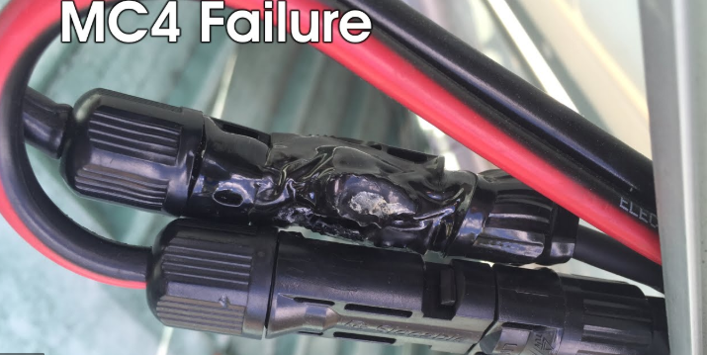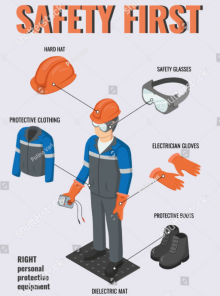
A Solar PV installer has to take care of the electricity related hazards at his site. This covers two hazards:
- Electric shocks and
- Arc flash Discharge
It is relevant to record that proper precautions and personal protection equipment is mandated the moment the voltage exposure is more than 30 V. DC voltage is considered dangerous beyond 50V and can ‘hold’ the exposed body part in a dangerous continued exposure. Currents more than 50mA can cause a fatal heart attack! DC Voltage is at zero frequency and hence is not self-quenching – in fact, it can cause a muscle contraction in the exposed person and cause him to ‘stick’ to the exposed live DC wire!
So what are the steps to electric safety? These are:
- First, there should be an awareness of the risk among the site users. The site users should develop a comprehensive Electric Safety Plan (ESP) covering the site hazards, processes, owners. This ESP can be developed by an independent authority or by an appropriately qualified team person. Ideally, the work done by an internal person should be qualified by an independent study – especially, for the arc flash hazard. Arc Flash hazards are a tremendous discharge of energy between two points because of breakdown of intervening gas into conduction ions- and can result in temperatures of 20000 celsius, creating fatal burns, blinding lights, deafening sound and melt/propel conductor pieces at shrapnel speeds. An independent safety study will definitely document the energy exposure (Calories/sq.cm), the safety distances, the exposure voltages and glove /PPE types recommended for the site work). Appropriate hazard labels should be placed on equipment and site users trained to read and react appropriately to the signages.
- It is relevant to de-energise all electric equipment before working on it. This means you start by switching off the DC disconnects and proceed with all relevant disconnects as you move along the single-line diagram ( AC disconnects , as well when u work on the inverter).
- It is relevant to inspect visually all connections after disconnect. Is the disconnect visually established? You should assume energy on terminals till it is tested and cleared. And – this should be independently tested by two people independently before you proceed with work on the electric equipment. It is critical to test for absence of voltage!
- For rooftop SPV, it is relevant to note that you are not likely to have a condition for working on energised equipment. An explicit supervisory clearance should be taken to work on live, energised equipment. This is where the arc-flash hazard comes from. As a rule, however – before you start – switch off!
- All de-energised equipment needs to be locked out tagged out, in an appropriate LOTO process/signage. Emergency procedures should also be well defined as a process to address any site incidence (including extracting impacted persons, safety approach limit marks, first aid etc).
- Right PPE is critical for users. For most Indian rooftop sites, a recommended PPE kit will cover: CATL 12 or 25 or 40 rated body suit, hard hat with Baklava, Safety Visors and Safety goggles, ear plugs, Rubber gloves (of appropriate ratings) with Leather protectors, Leather shoes, rubber floor sheets. (Of course, this will go up as site KW ratings cross 15-20KW)!
- Right Training is critical -for electricians and casual site users separately. It should be a combination of online / theoretical training – AND live training. Also, include emergency procedure trainings including rapid shut down procedures, use of insulated rescue hooks in case of an accident to retrieve personnel and first aid procedures for shock. PRACTICE electrical safety so that you are not shocked!
- Set up Safe Work Zones. Identify arc flash boundary( where u can stand without PPE and still survive) and limited approach boundary (where an unqualified worker can stand without PPE).
Major causes of DC Arcs in solar PV systems are :
- Moisture, pest ingress degrading connections in connectors, junction boxes and switches
- Incorrectly crimped connector contacts
- Mating of incompatible plugs and sockets (MC4 connectors)
- Plugs and sockets (MC4 connectors) not fully engaged
- Loose screw terminals within junction boxes or isolator switches
- Poorly soldered joints within a PV module junction box or other junction defects
- Damage to a component ( e.g., broken busbar within a PV module)
Major components of solar PV rooftop project associated with fire risk are:
- DC connectors (MC4 connectors)
- DC isolators and combiner boxes
- PV modules
Issues relating to DC connectors (MC4 connectors) that need to be watched out for are:
- Inferior quality and make of materials
- Improper crimping of cables to DC connectors
- Loose glands of DC connectors
- Improper mating of DC connectors
- Mating of different makes of DC connectors
Best practices to reduce fire risk are:
- Selection of quality and certified products
- Use of heavy duty crimping tool to crimp DC cables rather than pliers
- Proper tightening of glands using proper tools rather than hands
- Ensure proper mating of two connectors
- Avoid mating different makes, sizes or specification DC connectors with each other
Issues related to DC Isolators and Combiner Boxes that need to be watched out are:
- Water, rodent or insects ingress into combiner boxes due to:
- Open combiner boxes due to bad installation practices
- Drilling into combiner boxes to mount
- Improper gland size
- Many cables stuffed into a single gland
- No glands or loose glands
- Glands on upper side of combiner boxes
- Wrong wiring of DC isolators
- Wrong sizing and selection of DC isolators
- Inferior quality and makes of DC isolators and combiner boxes
- Wrong Surge Protection Device selection in DC combiner boxes
Best practices to reduce fire risk are:
- Selection of quality and certified products
- Ensure proper sealing and IP protection of combiner boxes by:
- Proper sizing, selection and wiring of DC isolators and surge protection devices
Issues related to Solar PV modules that need to be watched out are:
- Broken or damaged module junction boxes
- Loose connections of DC cables at module junction boxes
- Open circuit bypass diodes with partially shaded modules
Best practices to reduce fire risk are:
- Selection of quality and certified PV modules and junction boxes
- IR Thermal Imaging to identify open circuit bypass diodes and other hot points in the module
It is relevant to note that NEC 2017 mandates the use of inverters with AFCI (Arc Flash Circuit Interrupters) on the DC side. Again – it is using quality products and following standards coupled with good workmanship is key to a safe site. NEC (National Electric Code) standards are some of the best practise recommendations to build safe solar PV sites.
Good work practices are key to ensuring safety on site. As a rule, it is recommended that appropriate lines in the SLD is de-energised before doing electric work. PV panels are disconnected in pairs so that the combined voltage is within safe limits, visual inspection and voltage checks are done to ensure safe zones. Appropriate PPE should be worn and use of rubber gloves (& appropriate PPE) on site is mandated!
Proper appreciation of electric hazards and appropriate processes/practice/use of PPE is key to being a qualified electric worker! Safety is an attitude. Ttake pride in your work-put safety in every stride.

